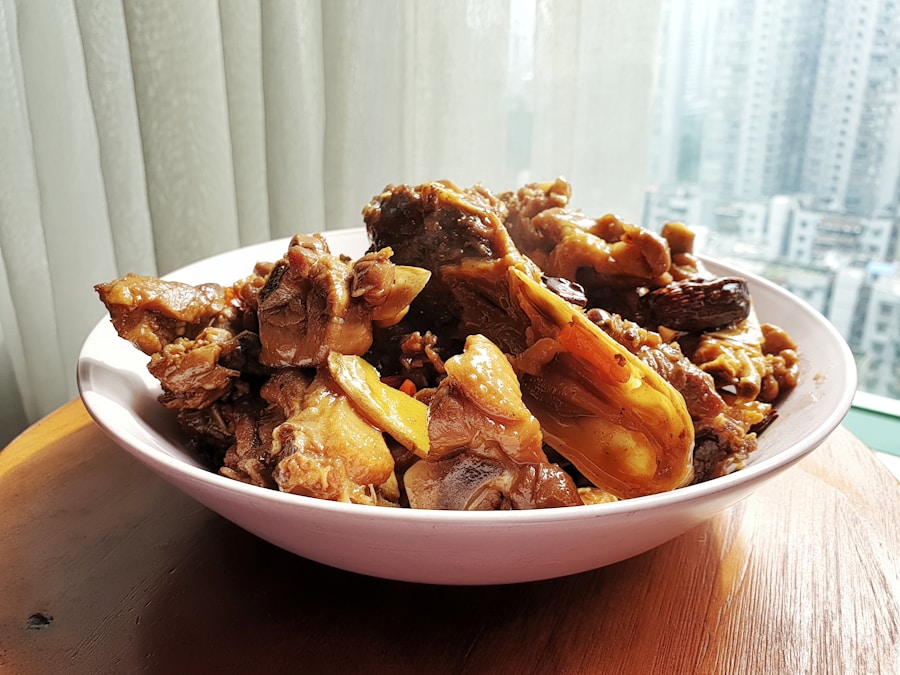Download links
How to install The Ultimate Guide to Perfect Adobo APK?
1. Tap the downloaded The Ultimate Guide to Perfect Adobo APK file.
2. Touch install.
3. Follow the steps on the screen.
Description
Adobo, a dish that has become synonymous with Filipino cuisine, boasts a rich and complex history that reflects the diverse cultural influences that have shaped the Philippines over centuries. The term “adobo” is derived from the Spanish word “adobar,” which means “to marinate.” This connection to Spanish colonial rule, which lasted for over three centuries, is significant in understanding how adobo evolved into the beloved dish it is today. The Spanish introduced various cooking techniques and ingredients, including vinegar and spices, which became integral to the Filipino version of adobo.
However, the roots of adobo can be traced back even further to indigenous cooking practices that utilized vinegar and salt for preservation long before the arrival of the Spaniards. The evolution of adobo is not merely a tale of culinary adaptation; it is also a reflection of the Philippines’ geographical and cultural diversity. Each region in the archipelago has its own interpretation of adobo, influenced by local ingredients and traditions.
For instance, in the northern regions, adobo may incorporate soy sauce and garlic, while in the Visayas, it might feature coconut milk for a creamier texture. This regional variation highlights how adobo has transcended its origins to become a canvas for creativity and personal expression in Filipino kitchens. The dish has also gained international recognition, often serving as an ambassador of Filipino cuisine, showcasing the unique flavors and cooking methods that define the archipelago’s culinary landscape.
Key Takeaways
- Adobo has a long history in Filipino cuisine, with its roots in the Spanish colonial era and influences from indigenous cooking methods.
- The key ingredients for the perfect adobo include vinegar, soy sauce, garlic, bay leaves, and black peppercorns.
- The best cooking techniques for adobo involve marinating the meat in the sauce for at least 30 minutes and then simmering it until tender.
- Variations of adobo include regional differences in ingredients and cooking methods, such as using coconut milk or adding pineapple.
- Serving suggestions for adobo include pairing it with steamed rice, pickled vegetables, and a side of fresh tomatoes and onions.
- Tips for perfecting your adobo include adjusting the vinegar and soy sauce ratio to your taste, using a mix of chicken and pork for added flavor, and experimenting with different types of vinegar for a unique twist.
Ingredients for the Perfect Adobo
Choosing the Right Meat
The perfect adobo begins with selecting high-quality ingredients that will enhance the dish’s flavor profile. The primary components typically include meat—commonly chicken or pork—but variations can include beef, seafood, or even vegetables for a vegetarian option. The choice of meat significantly influences the final taste; for instance, chicken adobo tends to be lighter and more delicate, while pork adobo offers a richer, more robust flavor.
The Importance of Freshness and Quality Ingredients
Freshness is key; sourcing local and organic meats can elevate the dish’s overall quality. The marinade is where adobo truly shines, and it usually consists of vinegar, soy sauce, garlic, bay leaves, and black peppercorns.
The Art of Balancing Flavors
The type of vinegar used can vary widely; cane vinegar is a popular choice in many regions due to its mild flavor, while coconut vinegar adds a unique sweetness and depth. Soy sauce contributes umami and saltiness, balancing the acidity of the vinegar. Garlic is often used generously, imparting a fragrant aroma that permeates the dish.
Some cooks may also incorporate additional ingredients such as onions, ginger, or even chili peppers to create a more complex taste.
The Best Cooking Techniques for Adobo

The cooking techniques employed in preparing adobo are crucial to achieving the desired flavor and texture. Traditionally, adobo is made through a two-step process: marinating and simmering. The marination phase allows the meat to absorb the flavors of the vinegar and soy sauce, enhancing its taste.
A minimum of 30 minutes is recommended for marination, but many chefs prefer to let it sit overnight for maximum flavor infusion. Once marinated, the next step involves simmering the meat in the marinade until it becomes tender and infused with flavor. This slow cooking process allows the meat to break down and absorb the aromatic qualities of the marinade fully.
Some cooks prefer to sear the meat first to develop a caramelized crust before adding the marinade; this technique adds an additional layer of complexity to the dish. The simmering time can vary depending on the type of meat used; chicken typically requires about 30 minutes, while pork may need up to an hour or more to achieve optimal tenderness.
These methods can significantly reduce cooking time while still yielding tender results. Pressure cooking is particularly effective for tougher cuts of meat, allowing them to become tender in a fraction of the time compared to traditional simmering methods. Slow cooking, on the other hand, allows flavors to meld beautifully over several hours, resulting in a deeply flavorful dish that showcases the essence of adobo.
Variations of Adobo
| Adobo Variation | Main Ingredients | Region |
|---|---|---|
| Adobo sa Gata | Chicken, pork, or seafood cooked in coconut milk | Philippines |
| Adobo with Pineapple | Chicken or pork with pineapple chunks | Philippines |
| Adobong Pusit | Squid cooked in soy sauce, vinegar, and garlic | Philippines |
| Adobo Blanco | Chicken or pork cooked without soy sauce | Philippines |
Adobo’s versatility is one of its most appealing characteristics, leading to numerous regional variations that reflect local tastes and available ingredients. One popular variation is “adobo sa gata,” which incorporates coconut milk into the traditional recipe. This version adds a creamy richness that balances the acidity of the vinegar and soy sauce, creating a luxurious mouthfeel.
Often enhanced with spices like turmeric or ginger, adobo sa gata is particularly popular in regions where coconut is abundant. Another notable variation is “adobong puti,” or white adobo, which omits soy sauce entirely in favor of a more straightforward combination of vinegar, garlic, and peppercorns. This version allows the natural flavors of the meat to shine through without the added umami from soy sauce.
It is often prepared with chicken or pork and is characterized by its lighter color and tangy flavor profile. Vegetarian adaptations have also emerged as more people seek plant-based options. Tofu or jackfruit can serve as excellent substitutes for meat in adobo recipes.
Tofu absorbs flavors well and provides a satisfying texture when cooked properly, while jackfruit mimics shredded meat’s consistency and can take on the rich flavors of traditional adobo marinades. These variations not only cater to dietary preferences but also showcase how adobo can be reimagined while retaining its core essence.
Serving Suggestions for Adobo
When it comes to serving adobo, presentation plays an essential role in enhancing the dining experience. Traditionally, adobo is served with steamed white rice, which acts as a neutral base that complements the dish’s bold flavors. The rice absorbs the savory sauce beautifully, making each bite harmonious.
For an added touch, some cooks garnish their adobo with freshly chopped green onions or fried garlic for an extra layer of flavor and visual appeal. In addition to rice, adobo can be paired with various side dishes that enhance its taste profile. For instance, pickled vegetables or “atchara” (pickled green papaya) provide a refreshing contrast to the richness of adobo.
The acidity from pickled sides cuts through the savory notes of the dish, creating a balanced meal that excites the palate. Another popular accompaniment is fried plantains or sweet potatoes; their natural sweetness complements the savory elements of adobo while adding textural variety. For those looking to elevate their dining experience further, serving adobo alongside a selection of Filipino appetizers can create a delightful feast.
Dishes like lumpiang shanghai (spring rolls) or pancit (stir-fried noodles) can round out a meal centered around adobo, showcasing the diversity of Filipino cuisine in one sitting.
Tips for Perfecting Your Adobo

The Importance of Marination Time
Allowing your meat to marinate for an adequate amount of time is crucial in achieving superior results. While 30 minutes may be sufficient in a pinch, letting your meat marinate overnight will yield a more flavorful dish. This extended time enables flavors to penetrate deeply into the meat fibers, resulting in a more flavorful adobo.
Balancing Flavors in Your Marinade
Another essential consideration is balancing acidity and saltiness in your marinade. It’s vital to taste your marinade before adding it to your meat and adjust accordingly. If it feels too acidic or salty, add more water or sugar to achieve harmony in flavors. Experimenting with different types of vinegar or soy sauce can also lead to exciting new flavor profiles.
Personalizing Your Adobo Recipe
Don’t be afraid to personalize your adobo recipe based on your taste preferences or dietary needs. Whether you prefer it spicier with added chili peppers or creamier with coconut milk, adapting traditional recipes allows you to create a version that resonates with your palate while honoring this iconic dish’s rich heritage. Embrace creativity in your kitchen, and remember that adobo is not just a recipe but a canvas for culinary expression that reflects both tradition and innovation in Filipino cuisine.
FAQs
What is Adobo?
Adobo is a popular Filipino dish that involves marinating meat, seafood, or vegetables in a mixture of vinegar, soy sauce, garlic, and other seasonings, then simmering it until tender.
What are the main ingredients in Adobo?
The main ingredients in Adobo typically include vinegar, soy sauce, garlic, bay leaves, and black peppercorns. The dish can be made with various proteins such as chicken, pork, beef, or seafood.
How is Adobo cooked?
To cook Adobo, the meat or other main ingredient is marinated in the vinegar and soy sauce mixture, then simmered in the same marinade until tender. It is often served with rice.
Is Adobo spicy?
Adobo can be made spicy by adding chili peppers or hot sauce to the marinade, but it is not traditionally a spicy dish. The level of spiciness can be adjusted to suit individual preferences.
What is the origin of Adobo?
Adobo is a traditional Filipino dish that has its roots in Spanish cuisine. The cooking method of marinating and stewing meat in vinegar and spices was introduced by the Spanish during their colonization of the Philippines.





